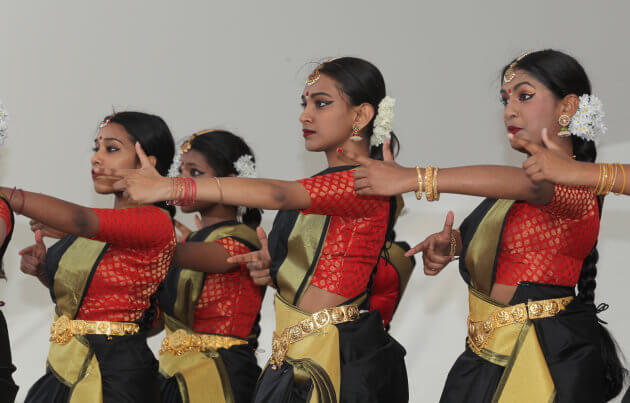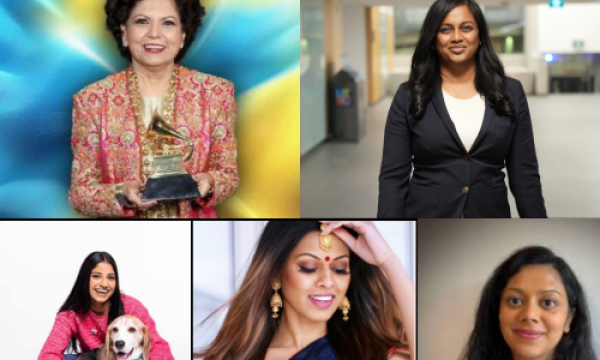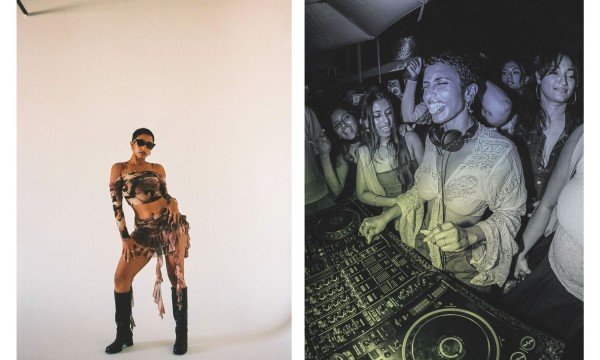
The sun shone through the windows of my elementary school. It was the fourth grade, and lunch time had just rolled around. Hungry, I pulled out a thermos full of last night's dinner out of my lunch bag. The lunch was rice with an assortment of curries, which wasn't an uncommon meal for a brown girl like myself to have.
However, when I opened the thermos lid, it hit me. An eye watering stench from the spices wafted in the air. I was horrified, and quickly took a few bites before shutting the lid on the thermos, as I feared the class would turn to me in disgust. I felt as though the smell still hovered over me, like a storm cloud. The names they would call me if I had left it open a little longer! I would be known as the girl with the stinky lunch. Stinky lunches were only the tip of the iceberg when it came to being Tamil.
This is who I am, a second generation Tamil-Canadian. Born and raised by parents who fled Sri Lanka in a time of crisis, in hopes to begin their life anew. War torn and littered with the bodies of their neighbours, friends and family, my parents leaving their homeland was the only plausible solution for their survival. They brought only the clothes on their backs and the culture that they were taught. For them, adapting to Canada's culture took them several years, as a part of them still held onto the Sri Lankan culture they grew up with since birth.
 Tamil Hindu children listen to prayers after performing a Bharatnatyam dance during the Nambiyaandaar Nambi Ustavam Thiruvizha pooja at a Hindu Temple in Ontario, Canada, on 19 July 2017. This pooja is part of the 15 day long festival that honours Lord Ganesh which culminates with the extravagant chariot procession. During this Puja an idol of Lord Ganesh is paraded around the temple as prayers are performed. (Photo by Creative Touch Imaging Ltd./NurPhoto via Getty Images)
Tamil Hindu children listen to prayers after performing a Bharatnatyam dance during the Nambiyaandaar Nambi Ustavam Thiruvizha pooja at a Hindu Temple in Ontario, Canada, on 19 July 2017. This pooja is part of the 15 day long festival that honours Lord Ganesh which culminates with the extravagant chariot procession. During this Puja an idol of Lord Ganesh is paraded around the temple as prayers are performed. (Photo by Creative Touch Imaging Ltd./NurPhoto via Getty Images)
I was raised as a Tamil girl.
Yet being raised in Markham, I was also raised as a Canadian girl, something which I identified with more than my Tamil upbringing.
I found out quickly through school that I wasn't like the other kids.
Going to school in Markham, I realized the differences between myself and my classmates. They didn't go to the temple and wear paavada satais like I did. They didn't eat meals with their hands at home like I did. They didn't have a brown complexion like I did. I didn't fit in because I looked different, because my life at home was different, because I was Tamil. I felt awkward and odd.
I never felt like a true Canadian when I noticed these differences. In my mind, I implemented the idea that to be a true Canadian, I had to leave behind my Tamil heritage. I would push away anything originating or involving Tamil culture, and in my mind, that's exactly what I did.
I would let my nose wrinkle in disgust when I ate Tamil food and I would whine to my mom when I had to dress up to go to the temple.
However, no matter how hard I tried to distance myself from my Tamil heritage, it would sneak up on me like a tiger and pounced onto me, knocking me down. My "Tamilness" stuck with me.
I was at a low. All I wanted to be was Canadian, not a Tamil girl. Yet, I couldn't distance myself from my Tamil culture. All I really wanted was to fit in, to truly be a Canadian.
Then, the question rang in my head: Why couldn't I have been born white?
To me, being white meant that you were Canadian, that you were better than everybody else, including and especially being Tamil. Being white meant you fit in and you held a higher importance in society.

My bias and admiration towards the white race entangled me with Linda Corey.
Linda Corey was the "it" girl, at least in the fifth grade. She had the quality of royalty and superiority. While we were only 10, any one of us would have walked through fire for her. And that's exactly what she wanted.
Her Russian descent gave her breathtaking ivory skin adorned with a splatter of freckles on her nose. In my eyes, she was the epitome of beauty. Compared to her, I felt like a mud stain in the classroom, with my toffee-coloured complexion and my lifeless dark brown eyes
I didn't know it, but beauty was only skin deep. Behind her green eyes was a mind which held the sole motive to use me to her advantage. Admiring her as I did, I wouldn't notice — or care — about her mastermind plan.
So began the series of events in which Linda raised her self-confidence by pointing out certain "flaws" I had, all while attacking my self-esteem.
Linda would shoo me away when telling secrets to her friends, even though she gave me the illusion that I was a 'sort of' friend to her. Of course, at the time I couldn't blame her, because I thought she was right. I was not worth telling secrets to, because I was brown. Whenever I had something new, or different than her (like a new manicure), Linda needed to have the same thing.
I guess in her mind, it was so I wouldn't rise to a different level than her. She always needed to be above me. I just mistook it for her false admiration for me. After all, she was white. She would do no harm and she was always right.
She continued to attack me.
At one point, our conversation during lunch went like this:
"What's that you're eating?" she said, clearly disgusted of my lunch.
"It's just cultural food," I mumbled to her, not knowing how to pronounce it in English. Amma (my mom) gave me rice and curry for lunch for the first time this week.
"Well it looks weird," she retorted, promptly eating her "white" food out of her Thermos. I looked at her with pristine focus as the surety on her face was as plain as day. She was right, what I was eating was weird. She couldn't have been lying because how else could she hold herself up with such confidence? I felt embarrassed to hold such food, and I slowly clicked the lid onto the container and slipped it into my lunch box. Why did I even bother to bring food like this to school anymore?
But I was too embarrassed to ask Amma (my mom) to stop giving the occasional rice and curry to me, as I was sure her feelings would get hurt.
All I wanted was redemption from Linda, a sign from her that showed me that I mattered, that I was worth something.
The sign never came.
"Why couldn't I have been born white? I asked myself. Then I would have been just like Linda, perfect and right in every possible way".
Linda moved to a new school in the sixth grade. Yet the damage she did lasted me the rest of elementary school. It wasn't until I reached high school that I started appreciating my heritage.
During the ninth grade in the month of November, Amma asked me to volunteer for Maaveerar Naal, a program established to pay tribute to the many Tamil soldiers who lost their lives in the Sri Lankan civil war. I have been going to every year ever since I was five, yet this is the first time I had volunteered. Nevertheless, I knew the story, and why there was an annual gathering at Markham Fair Grounds in November.
This war was fought between the Sri Lankan military and the Liberation Tigers of Tamil Eelam (LTTE). During this time, over 300,000 Sri Lankans migrated from Sri Lanka to Canada, including my parents. However, many family members of these Tamilian immigrants and refugees decided to stay; They wanted to protect their homeland and pave the way for their families to flee in safety.
I knew that many other Tamil families came to Maaveerar Naal to mourn and pay homage to the Tamils who fought in the war. To be a part of the effort that was ingrained in my cultural history, I told my mom that I would volunteer. I thought it would be something I would do for the rest of the night, collect my volunteer hours and go home.
However, going into the tent filled with thousands of Tamil people made me see more to Maaveerar Naal. There was more to it than respecting the soldiers who fought our fight. It was more about remembering the fathers, mothers, sons and daughters lost amidst the battle. These were people who have selflessly engaged themselves in the Sri Lankan civil war for a better tomorrow. They were human beings, just like myself. Seeing the pictures of those who have fallen - lined up against the wall - made me realize that their efforts shouldn't be brushed under the rug.
Even though I have been going for the past ten years, my eyes opened up for the first time in the tent and I truly saw what was right in front of me. I saw what they fought for. They fought for the safety of their families, the safety for the natives who remained in Sri Lanka and for the safety of countless Tamil immigrants and refugees who stood in Markham Fair Grounds today. I realized right then and there that I should have pride in saying that I am a young Tamil woman.
After volunteering at Markham Fair grounds, I decided to give myself a break of the torturous question "why couldn't I have been born white?" and started to be more open in reconnecting with my Tamil roots.
I didn't know where an appropriate place to start, so when Amma asked me to go to York Cinemas to watch a Tamil movie - rather than whining and complaining like I normally did when she took me to movies, I kept an open mind and went along. The movies we saw there, along with Amma's stories about Tamil culture and religion, inspired me to try and delve deeper into our culture and religion. I started by researching about the scientific reasoning of our customs and traditions, most of which I used to scoff at.
Researching and understanding made me feel closer to my Tamil heritage than I ever had before. I realized then that many second generation Tamil-Canadians like myself felt as though they needed to choose between acting upon Canadian culture, or Tamil culture, and wishing they didn't have their Tamil heritage in the first place. We don't want to be "too Tamil", which is evident because many of us feel embarrassed when we take something as simple as lunch out during school. We also don't want to be considered "whitewashed" when we don't know how to pronounce something in Tamil(which has happened to me a fair amount of times!) Like myself, many second generation Tamil-Canadians fought and continue to fight this identity battle within themselves.
There's a Tamil proverb that reminds me of how Tamil-Canadians should be towards each other. It goes like this: Adampan Kodiyum Thirandal Midukku. Translated, it means that union is strength. Rather than wasting our energy trying to prove how "Tamil" or how "Canadian" we are to each other, we should be more open and forthcoming to each other about the conflicts we face. Such as how we fear losing our Tamil culture our parents have taught us. How we fear that we don't even fit in and we are constantly being judged.
How some days, to avoid all of this confusion, we wish that we could have been born white. Us opening up to each other can finally make us realize that at the end of the day, we all face the same difficulties and it's okay to struggle. Every time one of us step forward to talk, the bond between each of us strengthens; and with that, the union between young Tamil-Canadians is fortified. We all become stronger - individually and as a group - when we come together.
I stopped asking myself, why couldn't I have been born white? because I learnt that being Canadian meant so much more than that. Being Canadian didn't mean you had to be a white person who enjoyed poutine and went to the cottage every other weekend. Being Canadian meant that you had to be kind and accepting towards others. Being Canadian meant being yourself, and for me, being a young Tamil woman was what being a Canadian was truly all about.
This article was originally published on the Huffington Post.

























